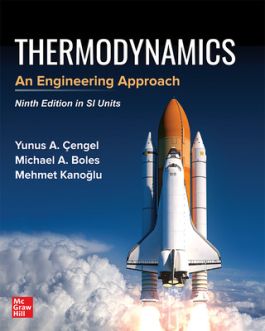EBOOK THERMODYNAMICS: AN ENGINEERING APPROACH IN SI UNITS
- Note: the eBook does not include access to Connect
- Access the eBook anytime, anywhere: online or offline
- Create notes, flashcards and make annotations while you study
- Full searchable content: quickly find the answers you are looking for
Chapter 2. Energy, Energy Transfer, and General Energy Analysis
Chapter 3, Properties of Pure Substances
Chapter 4. Energy Analysis of Closed Systems
Chapter 5. Mass and Energy Analysis of Control Volumes
Chapter 6. The Second Law of Thermodynamics
Chapter 7. Entropy
Chapter 8. Exergy
Chapter 9. Gas Power Cycles
Chapter 10. Vapor and Combined Power Cycles
Chapter 11. Refrigeration Cycles
Chapter 12. Thermodynamic Property Relations
Chapter 13. Gas Mixtures
Chapter 14. Gas-Vapor Mixtures and Air-Conditioning
Chapter 15. Chemical Reactions
Chapter 16. Chemical and Phase Equilibrium
Chapter 17. Compressible Flow
Appendix - Property Tables and Charts
The subject of thermodynamics deals with energy and has long been an essential part of engineering curricula all over the world. Its broad application area ranges from microscopic organisms to common household appliances, transportation vehicles, power generation systems, and even philosophy. This introductory book contains sufficient material for two sequential courses in thermodynamics and students are assumed to have an adequate background in calculus and physics. A conscious effort is made to emphasize the basic principles of thermodynamics while also providing students with a perspective of how computational tools are used in engineering practice. The traditional classical or macroscopic approach is used throughout the text with microscopic arguments serving in a supporting role as appropriate. This approach is more in line with students’ intuition and makes learning the subject matter much easier.

